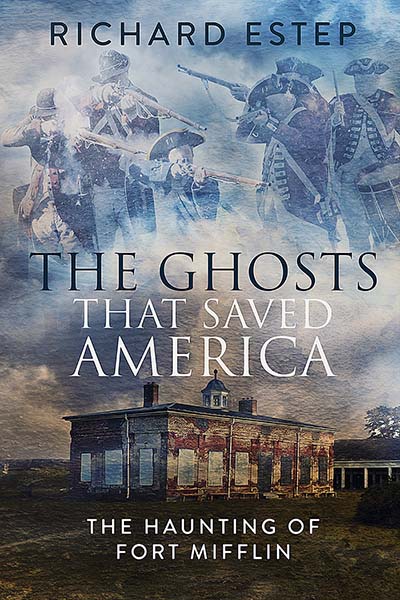As I finished the research for my forthcoming book about Gettysburg’s Farnsworth House Inn, I was fortunate to be granted an interview by none other than Brian Mallon, who portrayed General Winfield Scott Hancock in the films ‘Gettysburg’ and ‘Gods and Generals.’ I wanted to share it with my readers, so here goes.
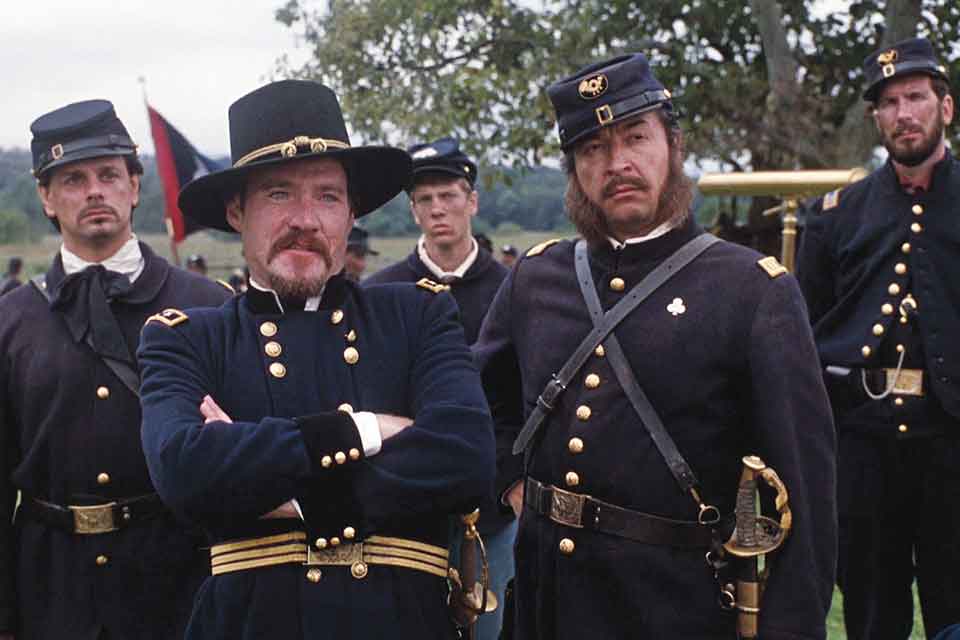
For those who heed its calling, the study of Civil War history involves far more than memorizing dates, places, events, and battles. Yes, it is about all of those things, but above all else, the personalities of the era stand out.
When it comes to the story of the Gettysburg campaign, some of those names shine very brightly indeed — names such as Lee, Longstreet, Chamberlain…and Hancock.
General Winfield Scott Hancock was a truly remarkable man. Born in 1824, Hancock was awarded a place at the U.S. Military Academy, West Point, sixteen years later. Surprisingly, he proved to be a less-than-stellar student, graduating nowhere near the top of his class. There were few indications that he would go on to serve his nation with great distinction twenty years later — and earn himself the soubriquet, ‘Hancock the Superb.’
Hancock served under General Winfield Scott during the Mexican War. His parents had named him after the general, so there was a certain synchronicity to this particular posting. It was in Mexico that Hancock first saw the face of battle in all its raw ugliness, and also suffered a wound whose after-effects would prevent him from being present at the moment of final victory.
1861 brought civil war, and saw Hancock stationed on the west coast, in California. During this time, he had become firm friends with a number of fellow army officers, who, tragically, he would end up facing on the opposite battle-line at Gettysburg. One, the steadfast and pious Lewis Armistead (ironically nicknamed ‘Lo’ or ‘Lothario’ by his men, a gentle jab at Armistead’s utter devotion to his wife) would become a true confidante and brother.
Starting out as a captain, Hancock’s rise through the ranks of the Union Army was nothing short of meteoric, something not particularly unusual during time of war — after all, many of the army’s finest officers had followed the call of their conscience, and departed its ranks in order to serve the Southern cause. That left a number of command billets to be filled at all levels.
Some appointments and promotions were unabashedly political, with commands being doled out to those who had the right connections. This never applied to Hancock, who developed a reputation for being a competent commander and outstanding tactician purely upon his own merits. He kept a cool head when under fire, and cared as much for the welfare of his troops as for his own safety — yet never at the expense of accomplishing the mission.
His continued success earned him the rank of Major General, and with it, a division of his own. More major engagements — including bloodbaths at Chancellorsville and Fredricksburg — cost him more wounds, but his richly deserved reputation as a true ‘fighting general’ also earned him command of the Army of the Potomac’s II Corps.
Then came Gettysburg.
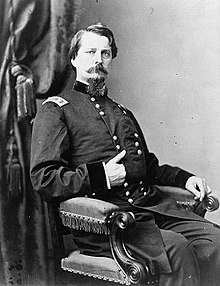
On the first day of the battle, Brigadier General John Buford and his blocking force of cavalrymen had one task: to snarl up the Confederate advance long enough for reinforcements to arrive. This they did with great gusto, forming consecutive lines of battle upon the ridges along the northern and western sides of Gettysburg. The horse soldiers soaked up each Confederate attack, blunting its momentum, making it stall, and then falling back to a fresh line of defense.
As the day wore on, those reinforcements finally came in the form of Major General John Reynolds, riding at the head of his I Corps. Reynolds was more than a Corps commander, though, because the head of the Army of the Potomac, George Meade, had given him commander of an entire wing. Reynolds was bringing more than 30,000 men to Gettysburg, and they were ready for a fight.
The fighting was particularly fierce at a place called Herbst Woods, where Reynolds found himself in the thick of it. The general’s head snapped backwards as a bullet ripped into his neck. Reynolds fell from his horse and lay motionless on the ground while the battle raged all around him.
General Meade could hardly believe it when he received word of his subordinate’s death. He needed somebody to take over the left wing of the army, and quickly. As he saw it, there were few suitable candidates who were capable enough to be entrusted with the job. Although there were other, more senior officers on the field, one name sprang to the fore immediately: Hancock. Meade dispatched him immediately to the battlefield, with orders to assume command of the forces in the field and provide him with an accurate appraisal of the tactical situation on the ground.
Meade had given Hancock the latitude to execute a fighting withdrawal from Gettysburg, if he judged it prudent to do so. One look at the terrain, and the respective battle formations of the two armies, told Hancock all that he needed to know. This was good ground on which to make a stand.
Hancock elected to stay and fight. He can therefore rightly be described as the man who guaranteed that a major battle would take place at Gettysburg. Had he chosen otherwise, the Army of the Potomac would have fallen back to a position of Meade’s choosing, with the intention of fighting Lee at another place and another time. His men fell back upon Cemetery Hill, where infantry and artillery positions would form a bulwark upon which the retreating Union forces could rally and re-form. Hancock’s calming influence soothed frazzled nerves, and helped restore a sense of equilibrium to units that had all but fled from their enemies.
The second day saw Hancock at the center of the Union line, commanding the entire southern half of the battlefield. Robert E. Lee, commanding the Army of Northern Virginia, hurled furious assaults against Meade’s left and right. Although the center saw less fighting, that which did occur was nothing short of ferocious.
Hancock prowled back and forth on Cemetery Ridge, directing the battle with a keen and practiced eye. Further south, a bloodbath was taking place in the Peach Orchard, thanks to the arrogance of Union general Daniel Sickles. Unhappy with the terrain he had been instructed to hold, Sickles had instead pushed his troops too far forward, seeking to seize and hold what he believed to be better ground. His men would pay dearly for his hubris. Sickles’s over-extended line formed a salient, bulging outward from the main line of defense and all but begging the enemy to smash it. This they promptly did, pummeling the beleaguered Federals from multiple sides.
Before anybody knew what was going on, the southern sector of the Union line was in danger of collapse. Now was the time for the Confederates to press their advantage, sending in a fresh wave of attackers against their opponents on Cemetery Ridge.
Fortunately, Hancock was there to steady the line. Ever-present where the fighting was fiercest, his natural air of authority buoyed his men’s spirits in the face of almost overwhelming enemy numbers. The boys in blue kept their nerve, trading shots with the lads in butternut and resolutely holding their ground. Hancock had positioned his troops precisely where he wanted them, using the terrain to their best advantage.
Confederate brigade after brigade assaulted the Union center, inexorably grinding the defenders down and beating them back. Suddenly, Hancock found himself in the middle of a crisis. A gray tide was rushing toward him, and his section of Cemetery Ridge was sparsely defended.
He was what was coming next: breakthrough, and inevitable collapse.
Hancock spurred his horse toward the closest friendly unit, which numbered just 262 men. They identified themselves as the 1st Minnesota, a name that would become infamous in the annals of Civil War combat, because their lives were about to be sacrificed in order for Hancock to buy the time he so desperately needed to organize a hasty defense.
The boys from Minnesota were tired but still had plenty of fight left in them. Hancock took their commanding officer, Colonel William Colvill Jr, aside, and pointed toward the mass of enemy troops now heading their way. Above the advancing enemy line fluttered a battle flag. Hancock ordered Colvill to get over there and take that flag from the Confederates.
One can only imagine what Colvill and his men thought of that order. They must certainly have known that Hancock was sending them to their deaths. But their reaction was to obey, and the small cluster of Minnesotans fixed bayonets and stormed the enemy formation. Although they checked the advance of the men from Alabama, the 1st Minnesota paid a terrible price. Confederates swarmed around them on all sides, hurling a storm of lead into their already-ragged ranks.
By the time the desperate encounter was over, the Minnesotans had lost more than eighty percent of their fighting strength, to death or severe wounding. It was the highest percentage of battlefield casualties taken by a unit at Gettysburg, on either side, and the second largest loss EVER inflicted upon any American unit in a single day’s action (in which the unit in question ultimately survived).
Hancock must have felt himself to be a butcher, sending so many brave young men to such a gruesome fate. And yet, he had done his duty, just as the Minnesotans had done theirs. The hopelessly heroic assault of the First Minnesota had plugged a crucial gap in his lines, which were stretched perilously thin — but held.
When the smoke cleared, 47 men straggled back to the Union lines to rejoin Hancock. Their valiant last stand had taken just twenty minutes. It would be easy to believe that this would have cut the heart out of the survivors, but the men from Minnesota were made of hardy stuff indeed; the following day, July 3, would see them once again standing in the Union battle line, helping to repel the massed Confederate assault known as Pickett’s Charge.
Pickett’s Charge was preceded by an earth-shattering cannonade. Practically every gun that the Confederates could bring to bear, was focused upon the Union line. The thunderous barrage was heard as far away as Baltimore. Chancing everything on one last throw of the dice, Robert E. Lee launched his remaining infantry brigades against the Union center on Cemetery Ridge. Lee had attacked both the enemy left and right on the preceding day. It was impossible for an army to be strong EVERYWHERE, Lee reasoned, and therefore, Meade’s center was probably the most vulnerable point. One single, overwhelming blow there might be decisive, if luck was with them.
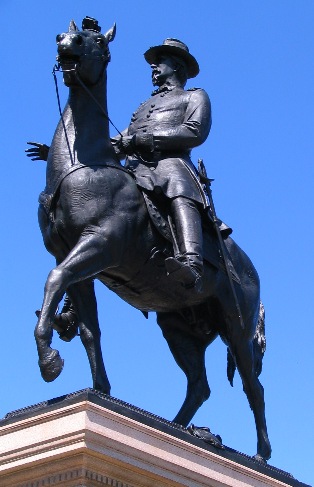
Luck was not with them. Meade had shifted some units around overnight, reinforcing his center and bolstering the units on Cemetery Ridge. The massed cannonade was surprisingly ineffective, doing little to soften up the defensive position that Pickett and his troops were ordered to attack.
Despite the fact that it made him a highly visible target, Hancock declined to dismount from his horse. Once again, he was to be found where the lead flew thickest, encouraging his men to stand their ground, come what may.
When a worried subordinate expressed concern for what he believed to be undue risk that Hancock was taking, he waved the man’s concerns away with a disdainful, “There are times when a corps commander’s life does not count.”
Predictably, a general on horseback was too tempting for Confederate soldiers to resist taking potshots at. Whether aimed or a stray, we will never know, but one bullet ricocheted from Hancock’s saddle and punched into the inside of his right thigh. Blood gushed from the open wound. Hancock’s aides helped him out of the saddle and laid him gently on the ground. Seeing that the bleeding was life-threatening, one officer applied a leather strap distal to the wound, acting as a tourniquet. It staunched the blood flow enough to save Hancock’s life.
Along with the shot itself, a saddle nail and several slivers of wood had also been driven into the wound. Hancock personally dug the nail out of his own leg, and even found the strength to make a joke about it.
Nobody could have blamed him if he had immediately turned over command to another qualified officer and allowed himself to be taken to the closest field hospital. Winfield Scott Hancock, however, was not that sort of man. He insisted upon staying put on the field, giving orders and directing his portion of the battle until events had been decided to his satisfaction. Only then did he permit himself to seek medical treatment.
After the battle was over, Hancock stayed in the fight for the long haul, serving as a general until the very end of the war. The wound he had sustained on Cemetery Ridge may have slowed him down, but it couldn’t stop him from doing what he did best.
The death of President Abraham Lincoln came as a shock to the people of the United States, Hancock included. The assassins were duly captured, arraigned, and sentenced. In what he found to be a rather distasteful assignment, Hancock was ordered to oversee the execution of the conspirators. While he found it to be somewhat distasteful, he was a man who did his duty, no matter what his own personal feelings might have been.
After the war, Hancock’s political aspirations came to the fore when he found himself running for president, opposing Republican James Garfield on the Democratic ticket. Hancock lost, and gave up on the prospect of the White House for good.
Despite developing diabetes, he led a fairly active life, right up until his death in 1886, from a systemic infection. Winfield Scott Hancock left behind a remarkable legacy, as both a superb soldier (to coin a phrase) and an honorable man. I would have given practically anything to sit down and talk with him, something which is, of course, impossible.
Luckily for me, I would be fortunate enough to do the next best thing.
As a young lad growing up in the United Kingdom, I had a long-standing fascination with the American Civil War in general, and with Gettysburg in particular.
Ronald Maxwell’s TV movie GETTYSBURG, an adaption of Michael Shaara’s Pulitzer Prize-winning novel THE KILLER ANGELS, was (and is) one of my favorite films. I watched those VHS tapes so often, I practically wore them out. Even now, before I fly out for a trip to Gettysburg, I watch the Blu-Ray the night before.
The cast is uniformly excellent. One of the stand-outs is Brian Mallon, who puts in a stellar turn as Winfield Scott Hancock, a role he would go on to reprise in the prequel, GODS AND GENERALS.
In a slightly surreal turn of events, shortly after my stay at the Farnsworth House, I was fortunate enough to obtain an interview with Brian, in which he shared his thoughts regarding both the shoot and the character of Hancock, not to mention a certain tavern on Baltimore Street…
Brian lives in Ireland, and our interview took place on a Sunday afternoon. I was more than a little bit awestruck to begin with, but he soon put me at my ease, and I was delighted to see the old expression that you should never meet your heroes be proven wrong. Brian is a fellow writer, and I very much appreciated him graciously giving up some of his valuable time in order to help me tell this particular story.
“I don’t really know much about the Farnsworth House ghost stories, other than the fact that there ARE such stories out there,” he said.
“That’s okay, sir—” I replied. He cut me off immediately.
“Don’t call me sir,” he chuckled. “‘Brian’ is fine.”
That was going to be a tough habit for me to break. Although he was a thoroughly nice man, I was already a little star-struck. Brian has a very cheerful and friendly voice, but it didn’t take a lot of imagination for me to hear the stern, stentorian tones of his character just beneath the surface.
Brian politely asked me about my home and background, putting me at my ease in the way that really good interviewees often do. Then discussion turned to the subject of GETTYSBURG, or THE KILLER ANGELS, as it had first been known.
Most actors audition for a role as part of the casting process. Brian’s experience on GETTYSBURG was different, and a little unorthodox. Back in the early 1990s, he was running a cafe on Hollywood Boulevard named Cafe Beckett (so called because they used to put on Samuel Beckett plays there). Brian was appearing in an award-winning play titled TRANSLATIONS.
One night, director Ron Maxwell was in the audience. He loved the performance, so much so that he came back to the Beckett afterward in order to cast Brian for a role in his upcoming mini-series project. After listening to Brian singing a few Irish songs in the cafe, he asked him to come over to discuss it.
No sooner had the two men sat down to chat than a friend of Brian’s happened to wander by. By a strange turn of fate, this gentleman, who was an Apache, happened to be wearing a Civil War-era general’s hat. Spotting Brian, he doffed the hat and placed it on top of his friend’s head.
The director watched, and suddenly burst out laughing. Brian was puzzled by his reaction; at this point, he still had no idea that he was being considered for the role of a Union general.
Brian tried to give the hat back, but his friend wouldn’t hear of it. “You keep it — it suits you!”
“Ron was initially talking about having me play [Sergeant Buster] Kilrain,” Brian explained, a role that subsequently went to the actor Kevin Conway. “But he changed his mind fairly quickly on that.
Actors are an unabashedly superstitious breed, particularly those who work in the theater. What were the odds, I wondered, of a man wearing a Civil War general’s hat happening to be in the cafe on the same night as the director of an upcoming Civil War production — not only that, but also then placing that hat on Brian’s head, and refusing to take it back because it sat so well?
“It almost sounds…FATED, for lack of a better word,” I pointed out.
“Well, it did seem that way to me too,” Brian agreed. “I took it as an omen. In fact, I kept that hat. I’ve still got it somewhere…”
Everybody involved with the production of GETTYSBURG knew that it would be scrutinized endlessly by Civil War aficionados, including the many re-enactors who would help create its vivid battle scenes. Every detail had to be right.
Once he was cast as the great general Winfield Scott Hancock, Brian dove into the minutiae of his subject’s life. There was no Internet to consult back then, so he hit the books, studying up on Hancock’s career and personality.
“Not just me…everybody did the same. We were given the names of books to read. The re-enactors know everything about everything, and you wouldn’t want to show up there and appear to be ignorant, you know? Sam Elliott [who played Brigadier General John Buford] had hired a researcher for himself, and he gave me a lot of material that he had found about Hancock. That was very useful.”
Winfield Scott Hancock was a remarkable man, something of which Brian was very aware, thanks to the reams of research material he had combed through.
“He would have been my favorite character of them all, so I was delighted when I found out that’s who I was playing. As I was reading up on him, I liked him. He was a Democrat, so he was glossed over a lot, in terms of the glories, with the Republicans being in office…although despite that, he made enough of a name for himself to run for president.”
I mentioned the fact that Hancock had been assigned with overseeing the execution of the Lincoln assassination conspirators, and that he hadn’t much liked the task.
“I don’t expect that he would,” Brian agreed. “Just because of the kind of man that he was. That would not have gone down well with him. He was a very conscientious fellow, well beyond corruption, and always did his duty. He probably would have been a very good president.”
Our conversation turned to the subject of the battlefield itself. Just walking the ground at Gettysburg, there is a sense that momentous things happened there.
“Gettysburg was a turning point in the war. So many fellows dead at the end of it — horrible. My mother’s side of the family was in America at that time, and my grandmother’s uncle, Jimmy Powers, fought in the war (though he wasn’t at Gettysburg).
“There is a wonderful aura about Gettysburg,” Brian went on. I asked him what it had felt like to be in uniform, riding a horse, at the head of columns of troops, with musketry and cannon fire going off all around him. “That took it to a whole new level. It was an incredible feeling to be out there like that, and in such a position. Of course, the center of the battlefield is so full of monuments, you couldn’t possibly film there…we were about a mile and a half up the way, where you had essentially the same land formations.
“I thought we did the story proud. That movie had a wonderful script. It was so accurate — Ron is amazing that way. I was there from day one of the shoot. The Confederates shot their scenes first. We all hung out at the Farnsworth House. Along with a couple of friends of mine from Ireland — Barry McEvoy and Conn Horgan — who were also on the film, we were called ‘the Irish Brigade.’ The fella who ran the book shop at the Farnsworth wrote up a piece about it that might be of interest to you.”
Brian was referring to a piece titled KILLER ANGELS ‘92: CAMPAIGN NOTES FROM THE FARNSWORTH TAVERN, written by John S. Peterson, a framed copy of which hangs in the tavern to this day. He writes:
Leading the Rebel pack was actor Tom Berenger. In the guise of Gen. James Longstreet, Berenger presented swords to all his officers, and in short order designated the Farnsworth House Tavern as the official “Officers Club” of the First Corps, Army of Northern Virginia. As might be expected, the Tavern soon became the scene of some of the merriest Civil War parties since Jeb Stuart rode rings around McClellan.
Mr. Peterson then goes on to recount actor Stephen Lang, playing the colorful Confederate cavalry general George Pickett, climbing on top of the bar and declaring: “At long last, I’ve taken the high ground.”
According to his account, the actors portraying the Union officers were a little less boisterous when they took over the Farnsworth Tavern after the boys in gray had vacated it. Brian Mallon was there until the very end of shooting, and grew very fond of the historic old house.
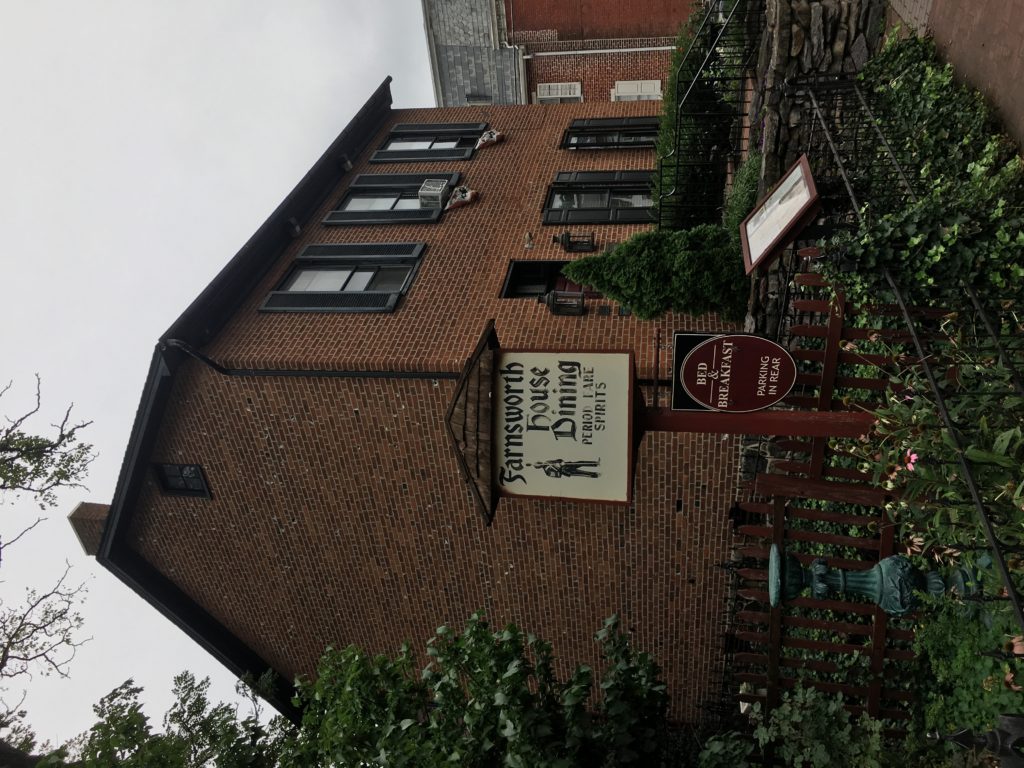
“The owners of the Farnsworth just let us have the run of the place. Everybody was so friendly. It was just a great place to be, and a lot of fun. I wasn’t too busy for the first few weeks of filming, so I was in there a lot. A good place to get a pint and just watch the world go by, and all in good company.”
Brian didn’t stay at the Farnsworth, being billeted instead at the equally historic Gettysburg Hotel in the center of town. He came back to Gettysburg for the 25th anniversary of the film, however, and didn’t pass up the chance to drop in at one of his favorite old haunts.
“I went back to the Farnsworth last spring. We got a nice greeting there. It’s such a great place. That’s where we hung out…our headquarters!”

